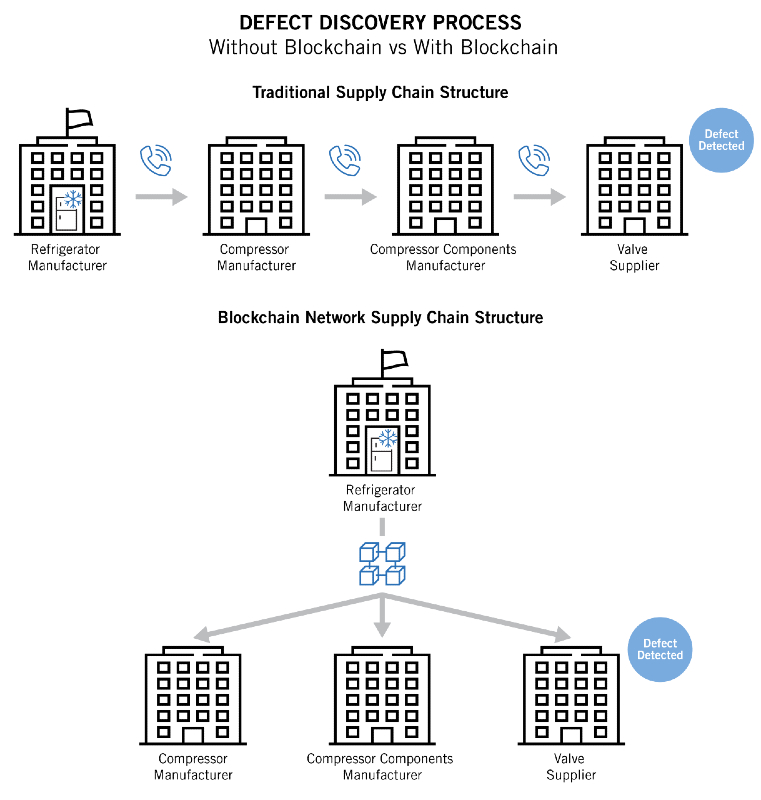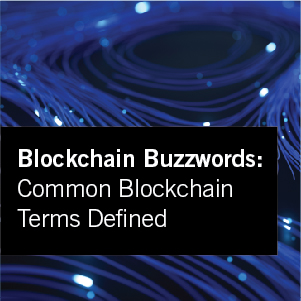
Blockchain has been heralded as a cutting-edge technology that will improve the contemporary supply chain structure by increasing supply chain trust, efficiency, and transparency. However, as promising as blockchain technology is, blockchain is not a panacea for supply chain issues. There are numerous pros and cons of using blockchain in the supply chain:
Some Pros of Blockchain
-
Trust. Because data on the blockchain is decentralized and immutable, members of the supply chain can trust the data they see on the blockchain. Conversely, a traditional supply chain data storage structure typically requires all members of the supply chain to keep their own records, and therefore disputes arise when those records do not match up.
- Efficiency. Because all data is recorded at every step in the supply chain, and every member of the supply chain can see the data, it is easy to quickly identify where in the supply chain a nonconformance (e.g., a product defect or missing product quantity) has occurred, because the life cycle of a product is tracked at every step. Let’s take, for example, the construction of a refrigerator. In the case of a traditional supply chain structure, if the refrigerator manufacturer discovers that the compressor of a finished refrigerator contains a defective valve, the refrigerator manufacturer will then need to reach out to the compressor manufacturer, who will need to reach out to the manufacturer of compressor components, and so on and so forth, up the supplier tiers until the supplier of the defective valve is reached. In contrast, if all members of the refrigerator supply chain were members of the same blockchain network, the refrigerator manufacturer would be able to query the blockchain to find the entire tracing history of the defective valve almost instantaneously, cutting investigation time down considerably. Using blockchain technology allows for less time lost sending emails and making phone calls to find out the cause of the nonconformance. Additionally, because documents are stored on a shared ledger, physical paperwork is largely unnecessary.
- Transparency. Blockchain engenders transparency because all data on the blockchain is recorded automatically with a time stamp, including certain data that usually would not be recorded in a traditional supply chain system (such as the steps completed in a production process or the time of a seller’s receipt of a purchase order). Blockchain technology also creates transparency by enabling end-to-end tracking (i.e., traceability from one end of the supply chain to the other), which can be enjoyed by all supply chain members on the blockchain. Blockchain transparency can accomplish quicker resolutions to disputes than with traditional supply chain systems.

Some Cons of Blockchain
- Permissioned Blockchains. Because supply chain information can be sensitive, a permissioned blockchain (that is, a blockchain that is not open to the public) is usually preferred. However, a permissioned system is less secure, because there are fewer nodes to make up the blockchain and those nodes are typically known to each other, resulting in an easier ability to collude to change a block.
- The Human Element. While there is great value in all members of a supply chain knowing that the data on the blockchain cannot be changed once it is established, there can still be human error or intentional misconduct in inputting the initial data onto the blockchain. Therefore, blockchain data is not perfect information – it could be false or even fraudulent.
 For instance, a bad actor could fill a container with rocks and record on the blockchain instead that the container was filled with auto parts. Blockchain technology could make it easier to detect at which stage in the supply chain the container was filled with rocks, but would not prevent the fraudulent data from hitting the blockchain in the first place. Essentially, blockchain technology does not prevent incorrect information from being entered onto the chain; it just allows every user on the blockchain to confirm that the data on the blockchain has not changed since a certain point in time. Because blockchain technology is traditionally immutable, fraudulent data inserted onto the chain is problematic. Accenture has developed a prototype to allow authorities of permissioned blockchains to edit previous transactions in extraordinary circumstances in order to resolve human error1, although some blockchain technologists have criticized such approaches to blockchain, stating that erasing immutability defeats the purpose of using blockchain over a traditional database.2
For instance, a bad actor could fill a container with rocks and record on the blockchain instead that the container was filled with auto parts. Blockchain technology could make it easier to detect at which stage in the supply chain the container was filled with rocks, but would not prevent the fraudulent data from hitting the blockchain in the first place. Essentially, blockchain technology does not prevent incorrect information from being entered onto the chain; it just allows every user on the blockchain to confirm that the data on the blockchain has not changed since a certain point in time. Because blockchain technology is traditionally immutable, fraudulent data inserted onto the chain is problematic. Accenture has developed a prototype to allow authorities of permissioned blockchains to edit previous transactions in extraordinary circumstances in order to resolve human error1, although some blockchain technologists have criticized such approaches to blockchain, stating that erasing immutability defeats the purpose of using blockchain over a traditional database.2 - Scaling. Blockchain solutions are far slower to process transactions than traditional databases, because the transactions must be validated on many different computers or servers. In addition, due to the high volume of transactions in supply chain, having a permissionless aspect of a blockchain solution could be costly, since transaction fees would need to be paid to fund the work performed by the miner nodes to create the blocks. Considering certain supply chains execute millions of transactions a day, the method in which blockchain technology is implemented must be thoughtfully approached with an eye towards scalability.
- Upfront Costs. The upfront costs of implementing a blockchain solution have the potential to be steep. There are costs associated with hiring blockchain developers, which tend to cost more than traditional developers due to their specialized area of expertise. Planning costs, licensing costs, and maintenance costs can also contribute to a hefty price tag.
While blockchain technology can potentially provide huge advantages to supply chains, there are also potential disadvantages that make it clear that any blockchain solution must be well-tailored to the targeted supply chain.
1 Editing the Uneditable, Accenture, https://www.accenture.com/us-en/insight-editing-uneditable-blockchain (last retrieved July 20, 2021).
2Accenture Breaks Blockchain Taboo with Editing System, Reuters (September 20, 2016), https://www.reuters.com/article/us-tech-blockchain-accenture/accenture-breaks-blockchain-taboo-with-editing-system-idUSKCN11Q1S2.

